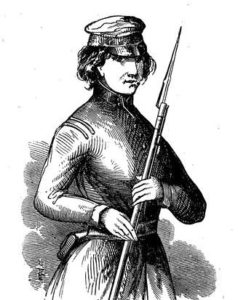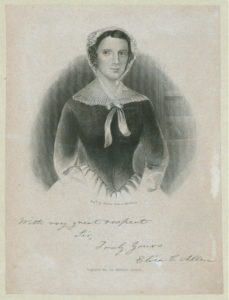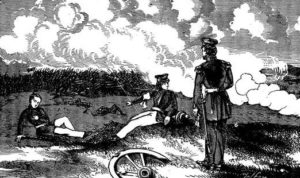
What could induce a woman in 1846 to trade her needlepoint for a rifle? The Mexican-American War began and several women, disguised as men, enlisted. Women’s places in society were restrictive back then. The gentle sex played supporting roles and stayed in the background. Nevertheless, history records women pushing against societal constraints by shedding their dresses and donning a soldier’s uniform.
In most cases, it was love that induced them to do it. They followed a man into the war.
Passing the physical exam
And in most cases, the U.S. Army caught them at the outset — during the physical exams required for enlistment. Military regulations required the volunteers to strip naked for the exam. This step allowed the army doctor to check for deformities hidden by clothing. They also checked for the telltale tattoos “D” or “HD,” signifying a deserter or habitual drunkard. But in the rush of getting the volunteers off to war, doctors didn’t always comply. In one case, the physicians examined an entire regiment fully clothed. [McCaffrey, 23-24]
And that’s how a few women slipped through.
The most famous enlisted woman in the war might have well been fictional, but I’ll start with her. In the next post, I’ll introduce some of the other women who served in the war … and whose stories are accepted.
How Eliza Allen Billings enlisted

Eliza Allen, a 20-year-old from a wealthy family in Eastport, Maine, fell in love with William Billings, a Canadian immigrant and day laborer beneath her class. When her parents forbid them to see each other again, he volunteered for the Mexican-American War. Eliza, in her grief, found inspiration in two women who’d previously fought in American wars – Deborah Sampson in the Revolutionary War and Lucy Brewer in the War of 1812. She sheared her hair, donned men’s clothing, and negotiated an enlistment under the name George Mead without a physical examination.
The lovers reunite

Unfortunately, Eliza didn’t make it into William’s company, which was now full. She couldn’t find William, even after they arrived in Mexico, but she knew he was there. They served under General Winfield Scott and survived the Siege of Veracruz, but both were wounded at Cerro Gordo. It was in the hospital at Cerro Gordo where she found William again. The two recuperated together and spent the rest of the war together. But Eliza maintained her cover. William never recognized his lover, and in fact, told “George” of his undying love for Eliza.
After the war, William and “George” followed the gold rush to California, traveling by ship around Cape Horn. Eliza still maintained her cover. The two struck it rich at a Californian stream (40 thousand dollars worth of gold!) and returned to the East Coast, where to William’s great surprise, Eliza revealed herself. Eliza’s parents, so relieved at the return of their daughter, now allowed them to wed.
The premise of this little bestseller was that parents should not interfere in their children’s choices of partners. But one’s fantasy has to do quite a bit of gymnastics to accept the idea that William, despite a couple of years of intimate life with “George,” never recognized his lover. Nevertheless, the book was such a success Eliza Allen Billings published a sequel in 1856, a brief biography of her mother.
Did Eliza Allen Billings really exist?
Historians have not been able to document William’s or Eliza’s existence. Recently, Shelby Harriel, an expert on female soldiers in the Civil War, made an attempt to track down the couple’s muster roll cards. There are no cards for a William Billings or George Mead among the Maine volunteers. She did find a record of a William Billings getting married in Eastport, Maine on Sept. 4, 1848, directly following the war. But his spouse was a Francis E. Richardson, not Eliza Allen. And according to the narrative, William and Eliza would have been in California at that time anyway. To be doubly certain, one would have to check Canadian records, since it’s possible the couple moved to William’s native land.
Eliza Allen Billings might not have been real, but other female soldiers in the war were. I’ll introduce them in the next post.
Despite its feminist streak, Eliza’s book became a bestseller. Why do you think people liked this story?
Literature on Point:
Eliza Allen Billings, The Female Volunteer; or, The Life and Wonderful Adventures of Miss Eliza Allen, a Young Lady of Eastport, Maine (Philadelphia, D. Rulison, 1851)
Eliza Allen Billings, The nobleman’s daughter, being an authentic and affecting narrative of the life and trials of Mrs. Sarah E. Allen, mother of Eliza Allen, the brave volunteer of Mexico … Written by Eliza Allen, author of the “Female volunteer.” (Philadelphia, D. Rulison, 1856)
James M. McCaffrey, Army of Manifest Destiny: The American Soldier in the Mexican War: 1846-1848 (New York University Press, 1992)
Shelby Harriel, “They fought in the Mexican War, too!” (blog post, July 1, 2015)
Spence Tucker et al., eds., The Encyclopedia of the Mexican-American War (Santa Barbara: ABC-CLIO, 2013) s.v. “Billings, Eliza Allen,” “Women, U.S.”



I enjoyed reading your post on Eliza Allen and look forward to the follow up containing more accounts!
Thanks so much, Shelby!The sleuthing you did for your blog provided invaluable material for this post, so I should be the one thanking you!
[…] women enlist in the Mexican-American War? Last week I blogged about Eliza Allen Billings. She wrote a bestselling book about fighting in the war disguised as a man. Most historians, […]